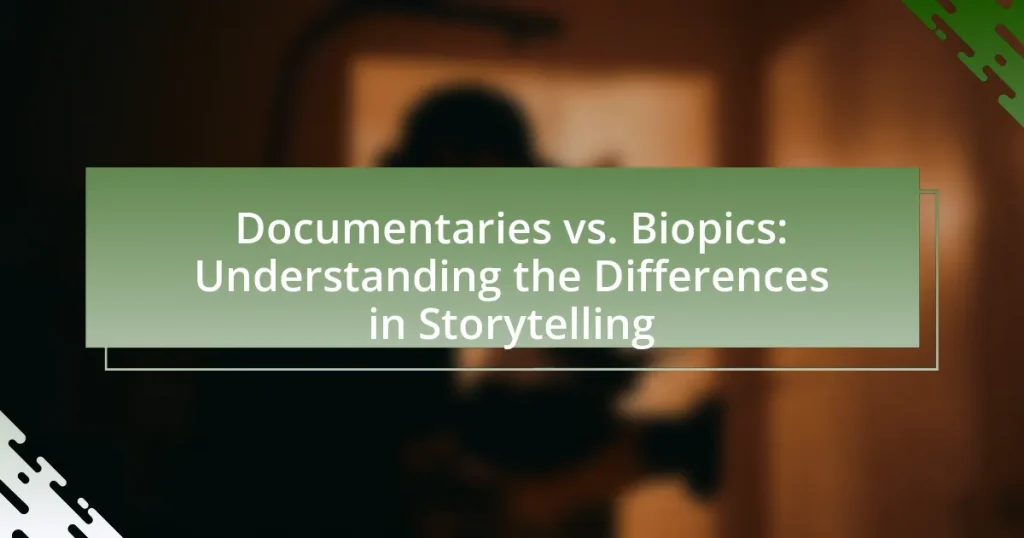Documentaries and biopics are two distinct forms of storytelling that serve different purposes in film and television. Documentaries are non-fiction works that aim to present factual information about real events, people, or issues, often utilizing interviews and archival footage to convey truth. In contrast, biopics dramatize the lives of historical figures, blending factual elements with creative storytelling to enhance emotional engagement. This article explores the defining characteristics, storytelling techniques, and audience perceptions of both genres, highlighting their importance in education, cultural understanding, and entertainment. Additionally, it examines how filmmakers can effectively choose between these formats to align with their narrative intent and audience expectations.

What are Documentaries and Biopics?
Documentaries are non-fiction films or television programs that document reality for the purposes of instruction, education, or maintaining a historical record. They often include interviews, archival footage, and real-life events to present factual information. Biopics, on the other hand, are dramatized films that portray the life of a historical figure, often blending factual events with creative storytelling to enhance emotional engagement. For instance, the film “The Theory of Everything” depicts the life of physicist Stephen Hawking, combining factual elements with dramatization to create a compelling narrative.
How do Documentaries differ from Biopics?
Documentaries differ from biopics primarily in their approach to storytelling and representation of reality. Documentaries aim to present factual information about real events, people, or issues, often using interviews, archival footage, and observational techniques to convey truth. In contrast, biopics dramatize the lives of individuals, often taking creative liberties to enhance narrative engagement, focusing on emotional arcs and character development rather than strict adherence to factual accuracy. For instance, the documentary “13th” explores the history of racial inequality in the United States through interviews and historical footage, while the biopic “The Theory of Everything” portrays the life of Stephen Hawking with a narrative that emphasizes personal relationships and struggles, sometimes at the expense of factual precision.
What are the defining characteristics of Documentaries?
Documentaries are characterized by their commitment to factual storytelling, often presenting real-life events, people, and issues. They utilize interviews, archival footage, and observational techniques to convey information and provide insight into their subjects. For instance, the documentary “13th” by Ava DuVernay explores the history of racial inequality in the United States through a combination of expert interviews and historical footage, illustrating the impact of systemic racism. This reliance on real-world evidence and the aim to inform or provoke thought distinguishes documentaries from fictional narratives.
What are the defining characteristics of Biopics?
Biopics are films that dramatize the life of a historical figure, focusing on significant events and personal experiences. They typically emphasize character development, showcasing the subject’s motivations, struggles, and achievements, often blending factual events with creative storytelling. Biopics frequently include a narrative arc that highlights pivotal moments, such as triumphs or tragedies, to engage the audience emotionally. For instance, films like “The Theory of Everything,” which portrays Stephen Hawking’s life, illustrate how biopics can humanize complex figures while remaining rooted in their real-life experiences.
Why are Documentaries and Biopics important in storytelling?
Documentaries and biopics are important in storytelling because they provide authentic narratives that educate and inspire audiences. Documentaries present factual accounts of real events, offering insights into social issues, history, and culture, which can foster awareness and understanding. For example, the documentary “13th” explores the intersection of race, justice, and mass incarceration in the United States, prompting discussions about systemic racism. Biopics, on the other hand, dramatize the lives of notable individuals, humanizing historical figures and making their stories relatable. The film “The Theory of Everything,” which portrays the life of physicist Stephen Hawking, illustrates personal struggles and triumphs, making complex scientific concepts accessible to a broader audience. Together, these forms of storytelling enrich cultural discourse and contribute to a deeper understanding of the human experience.
How do they contribute to cultural understanding?
Documentaries contribute to cultural understanding by presenting factual narratives that explore diverse societies, traditions, and historical events. They provide viewers with insights into different cultural practices, beliefs, and social issues, often highlighting underrepresented voices and perspectives. For instance, the documentary “13th” by Ava DuVernay examines the intersection of race, justice, and mass incarceration in the United States, fostering a deeper understanding of systemic racism. This factual representation encourages empathy and awareness, allowing audiences to engage with cultures beyond their own experiences.
What role do they play in education and entertainment?
Documentaries and biopics serve crucial roles in education and entertainment by providing factual narratives and dramatized portrayals of real-life events and individuals. Documentaries educate audiences through in-depth analysis, research, and factual storytelling, often addressing social issues, historical events, or scientific discoveries, thereby enhancing knowledge and awareness. For instance, the documentary “13th” by Ava DuVernay explores the history of racial inequality in the United States, offering viewers a comprehensive understanding of systemic racism. Biopics, on the other hand, entertain while also informing by dramatizing the lives of notable figures, often highlighting their struggles and achievements, which can inspire and motivate audiences. An example is “The Theory of Everything,” which depicts the life of physicist Stephen Hawking, blending entertainment with insights into his scientific contributions and personal challenges. Together, these formats enrich the educational landscape while captivating audiences through storytelling.

What storytelling techniques are used in Documentaries and Biopics?
Documentaries and biopics utilize various storytelling techniques to convey their narratives effectively. Both genres often employ interviews to provide personal insights and perspectives, enhancing emotional engagement. Additionally, documentaries frequently use archival footage and photographs to establish authenticity and context, while biopics rely on dramatization and character development to create compelling narratives. Voice-over narration is another common technique, guiding the audience through the story and providing necessary background information. These techniques collectively serve to immerse viewers in the subject matter, making the storytelling more impactful and relatable.
How do Documentaries utilize real-life events in their narratives?
Documentaries utilize real-life events in their narratives by presenting factual accounts and firsthand experiences to convey authentic stories. This approach allows filmmakers to explore complex social issues, historical events, or personal journeys, often using interviews, archival footage, and observational techniques to enhance credibility. For instance, the documentary “13th” by Ava DuVernay examines the history of racial inequality in the United States, utilizing historical data and expert interviews to support its narrative. This method not only informs viewers but also engages them emotionally, making the real-life events resonate on a personal level.
What methods do Documentaries use to present facts and interviews?
Documentaries use various methods to present facts and interviews, including direct interviews, archival footage, voice-over narration, and visual aids. Direct interviews allow filmmakers to capture firsthand accounts from subjects, providing authenticity and personal perspectives. Archival footage serves to contextualize the narrative, offering historical evidence that supports the documentary’s claims. Voice-over narration helps to guide the audience through the material, clarifying complex information and connecting different segments. Visual aids, such as graphs and photographs, enhance understanding by illustrating key points and data. These methods collectively ensure that documentaries effectively convey factual information while engaging viewers.
How do Documentaries create emotional engagement with the audience?
Documentaries create emotional engagement with the audience by presenting real-life stories that evoke empathy and connection. They often utilize personal narratives, compelling visuals, and authentic interviews to draw viewers into the experiences of individuals or communities. For instance, documentaries like “Won’t You Be My Neighbor?” highlight the life of Fred Rogers, showcasing his genuine compassion and the impact of his work, which resonates emotionally with viewers. Additionally, the use of music and pacing in documentaries can enhance emotional responses, as seen in “The Act of Killing,” where haunting scores amplify the gravity of the subject matter. These techniques effectively foster a sense of shared humanity, prompting audiences to reflect on their own lives and values.
What narrative structures are common in Biopics?
Common narrative structures in biopics include chronological storytelling, flashbacks, and thematic organization. Chronological storytelling presents events in the order they occurred, allowing viewers to follow the subject’s life journey clearly. Flashbacks are often used to provide context or insight into pivotal moments, enhancing emotional depth and understanding of the subject’s motivations. Thematic organization focuses on specific themes or periods in the subject’s life, allowing for a more focused exploration of their impact or legacy. These structures are prevalent in successful biopics, such as “The Social Network,” which employs a mix of chronological and flashback techniques to depict the rise of Facebook and its founder, Mark Zuckerberg.
How do Biopics balance fact and dramatization?
Biopics balance fact and dramatization by selectively portraying real events and characters while enhancing emotional engagement through creative storytelling techniques. Filmmakers often base their narratives on historical records, interviews, and biographies, ensuring a foundation of factual accuracy. However, they may alter timelines, combine characters, or exaggerate events to heighten drama and maintain audience interest. For instance, the film “The Social Network” presents a dramatized version of Mark Zuckerberg’s founding of Facebook, incorporating real events while emphasizing conflict and character development to create a compelling narrative. This approach allows biopics to resonate with viewers emotionally while still being rooted in factual elements.
What techniques do Biopics use to develop character arcs?
Biopics use techniques such as dramatization, selective storytelling, and character juxtaposition to develop character arcs. Dramatization allows filmmakers to enhance emotional engagement by portraying pivotal moments in a subject’s life, often exaggerating events for dramatic effect. Selective storytelling involves focusing on specific periods or events that highlight the character’s growth or decline, thereby shaping the audience’s perception of their journey. Character juxtaposition contrasts the biopic’s main character with secondary characters, emphasizing their traits and decisions, which further enriches the character arc. These techniques are evident in films like “The Social Network,” where the dramatization of Mark Zuckerberg’s creation of Facebook illustrates his transformation from a socially awkward student to a powerful entrepreneur.

What are the audience perceptions of Documentaries and Biopics?
Audience perceptions of documentaries and biopics vary significantly, with documentaries often viewed as more factual and informative, while biopics are seen as dramatized interpretations of real events. Research indicates that viewers appreciate documentaries for their authenticity and educational value, as they provide insights into real-life issues and historical events. In contrast, biopics are perceived as entertaining narratives that blend fact with creative storytelling, allowing audiences to connect emotionally with the characters portrayed. A study published in the Journal of Media Psychology found that 70% of respondents preferred documentaries for their realism, while 65% favored biopics for their engaging storytelling. This highlights the distinct roles both genres play in shaping audience perceptions and experiences.
How do viewers respond differently to Documentaries compared to Biopics?
Viewers respond differently to documentaries compared to biopics primarily due to the nature of storytelling and emotional engagement. Documentaries often evoke a sense of realism and factual engagement, as they present real events and people, leading viewers to respond with critical thinking and analytical perspectives. In contrast, biopics dramatize real-life stories, which can elicit stronger emotional responses through narrative techniques, character development, and artistic interpretation. Research indicates that documentaries can enhance viewers’ understanding of complex issues, while biopics may foster empathy and personal connection to the characters portrayed. For example, a study published in the Journal of Media Psychology found that viewers of documentaries reported higher levels of cognitive engagement, while those who watched biopics experienced greater emotional involvement.
What factors influence audience engagement with Documentaries?
Audience engagement with documentaries is influenced by several key factors, including storytelling techniques, emotional resonance, and the relevance of the subject matter. Effective storytelling techniques, such as narrative structure and pacing, capture viewers’ attention and maintain interest throughout the film. Emotional resonance, achieved through relatable characters and impactful themes, fosters a connection between the audience and the content, enhancing engagement. Additionally, the relevance of the subject matter to the audience’s interests or current societal issues can significantly increase viewer investment. Research indicates that documentaries addressing timely topics or personal stories tend to attract higher engagement levels, as they resonate more deeply with viewers’ experiences and concerns.
What factors influence audience engagement with Biopics?
Audience engagement with biopics is influenced by factors such as the relatability of the subject, the quality of storytelling, and the emotional resonance of the narrative. Relatable subjects, such as well-known historical figures or contemporary icons, draw viewers in due to their familiarity and the audience’s pre-existing interest. High-quality storytelling, characterized by strong character development and compelling plot arcs, enhances viewer investment in the narrative. Emotional resonance, achieved through authentic portrayals and impactful moments, fosters a deeper connection between the audience and the film. Research indicates that biopics that effectively combine these elements tend to achieve higher viewer ratings and engagement metrics, as evidenced by the success of films like “The Theory of Everything” and “Bohemian Rhapsody,” which received critical acclaim and audience appreciation for their engaging narratives and relatable subjects.
What can filmmakers learn from the differences between Documentaries and Biopics?
Filmmakers can learn that documentaries prioritize factual representation while biopics focus on dramatized narratives. Documentaries rely on real events, interviews, and archival footage to convey truth, as seen in films like “13th,” which explores systemic racism through historical context. In contrast, biopics, such as “The Theory of Everything,” take creative liberties to enhance emotional engagement, often condensing timelines and altering events for dramatic effect. Understanding these distinctions allows filmmakers to choose appropriate storytelling techniques that align with their intended message and audience expectations.
How can understanding these differences improve storytelling techniques?
Understanding the differences between documentaries and biopics can significantly enhance storytelling techniques by allowing creators to tailor their narratives to the strengths of each format. Documentaries rely on factual representation and real-life events, which can engage audiences through authenticity and emotional resonance, while biopics often dramatize personal stories, enabling deeper character exploration and emotional connection. By recognizing these distinctions, storytellers can effectively choose the appropriate medium to convey their message, ensuring that the narrative aligns with the intended emotional impact and audience engagement. For instance, a documentary about a historical figure can provide factual context and real interviews, while a biopic can dramatize pivotal moments in that figure’s life, thus appealing to different audience expectations and enhancing the overall storytelling experience.
What best practices should filmmakers consider when choosing between a Documentary and a Biopic?
Filmmakers should consider the narrative intent and audience engagement when choosing between a Documentary and a Biopic. Documentaries aim to inform and present factual content, often relying on real events and interviews, while Biopics dramatize the life of an individual, blending fact with creative storytelling to evoke emotional responses. For instance, a filmmaker might choose a Documentary to explore social issues, as seen in “13th,” which examines systemic racism in the U.S., using interviews and archival footage to present a compelling argument. Conversely, a Biopic like “The Theory of Everything” dramatizes Stephen Hawking’s life, focusing on personal relationships and emotional arcs to connect with viewers. Understanding these distinctions helps filmmakers align their project with their storytelling goals and audience expectations.




